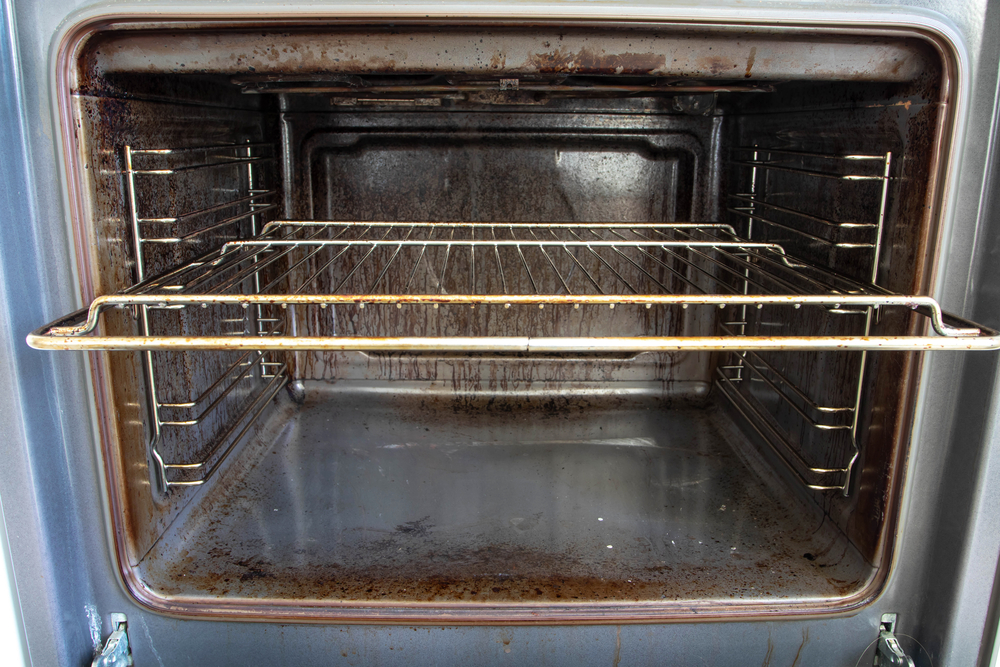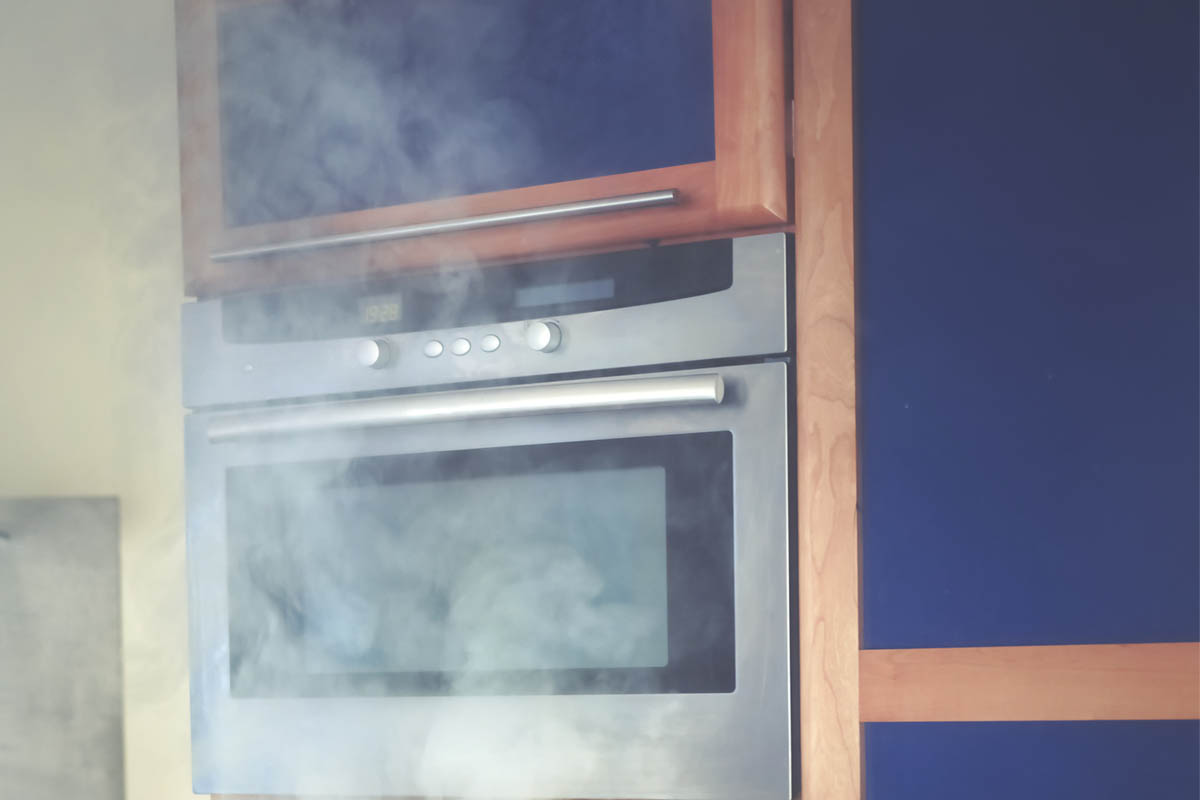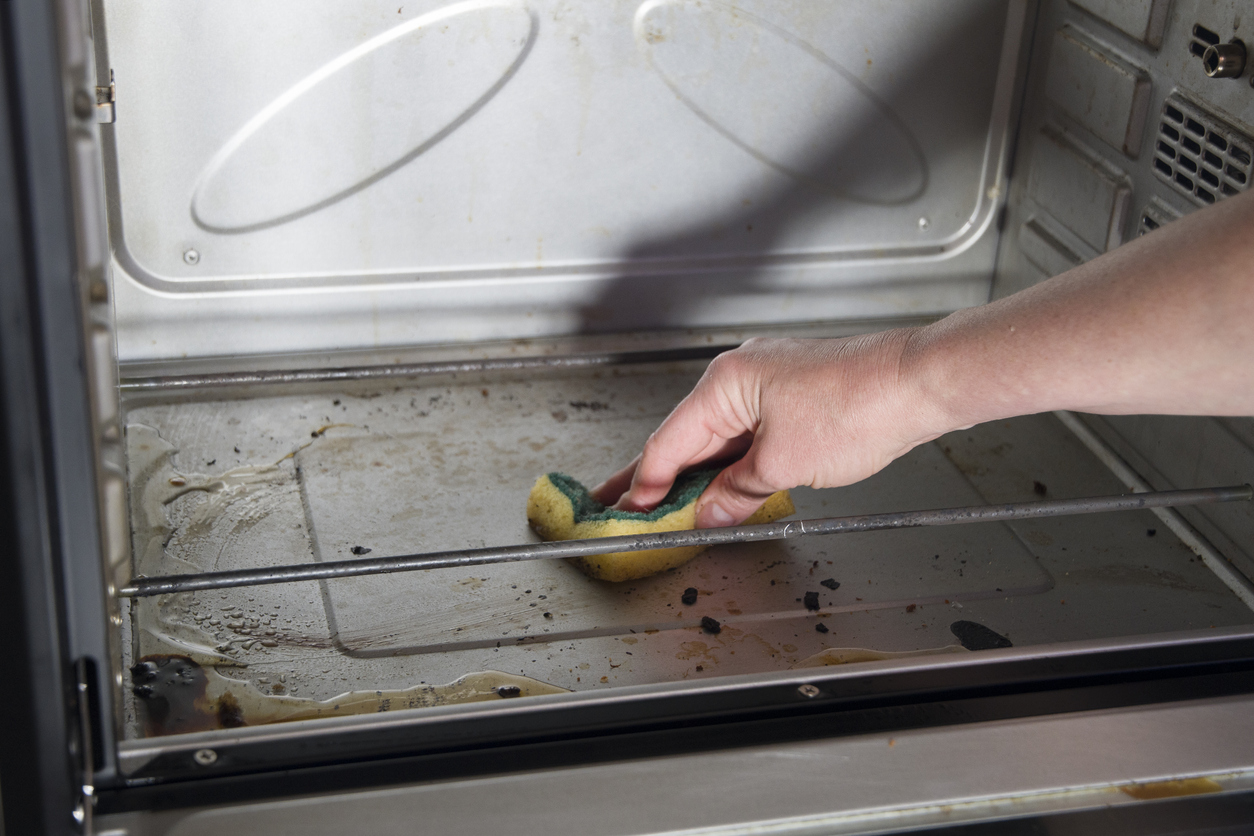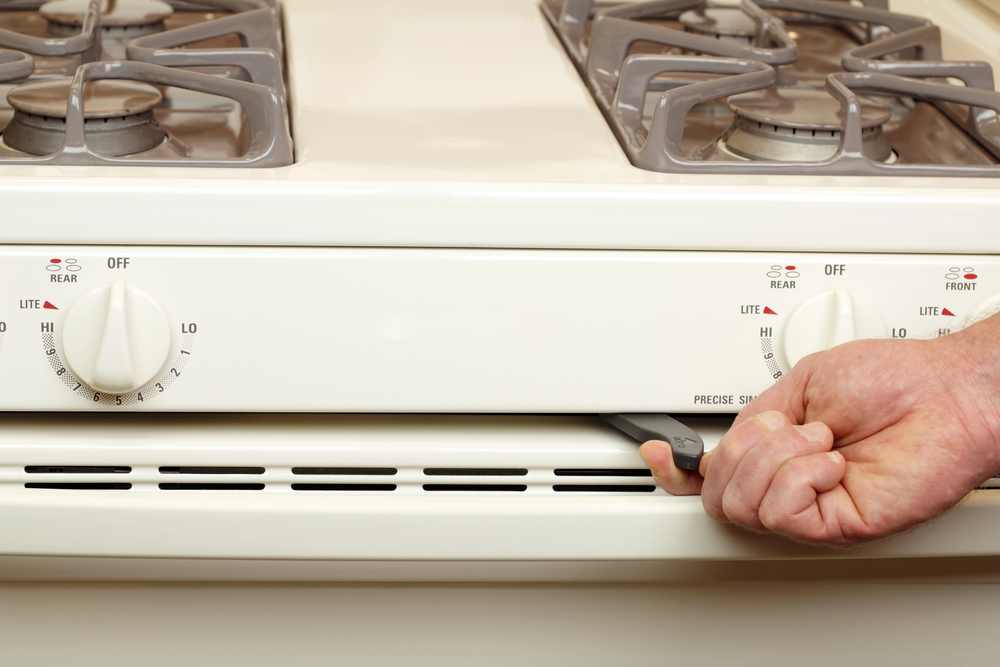We may earn revenue from the products available on this page and participate in affiliate programs. Learn More ›
Self-cleaning features on ovens, which can be confusing and even controversial, were developed in the early 1960s for both gas and electric ovens, though the term “self-cleaning” is actually something of a misnomer because ovens will always require some manual cleaning. What’s more, the function is by no means intended to replace a hands-on cleaning routine.
Some folks swear by the feature’s time-saving convenience, while others have sworn it off due to a few unfortunate downsides. Is it right for you? Once you learn how to use a self-cleaning oven, you can decide whether this feature is one you’d like to use.
How does a self-cleaning oven work?

The self-clean function works by blasting either high heat or steam throughout the oven interior to release—and burn up in the case of high-heat ovens—hardened food remains.
- In high-heat models, the self-clean cycle is usually initiated by closing the oven door and setting the oven to “self-clean” mode. In most modern ovens, the oven door locks automatically and the temperature rises to between 800 and 1,000 degrees Fahrenheit to incinerate any food particles. Once the cycle is complete and the oven has cooled completely, the door unlocks automatically.
- The self-clean cycle of a steam-based model is usually initiated by pouring roughly 1 cup of distilled water into the floor of the oven, then closing the door and setting the appliance to “steam-clean” mode. During the cycle, the oven door remains unlocked and the interior temperature rises to about 250 degrees Fahrenheit, hot enough to generate steam that softens and loosens food remains.
Is it safe to use the oven’s self-cleaning feature?

If you take the proper precautionary measures and adhere to the manufacturer’s instructions, it is safe to use an oven’s self-clean function and there’s no need to worry that a self-cleaning oven will kill you. “There’s very little evidence that the self-cleaning cycle of an oven can be unsafe and damage your appliance,” says licensed electrician and appliance repair technician David Miloshev, who works with UK-Based Fantastic Services.
There are, however, some self-cleaning oven risks to consider. It’s important to know that both high-heat and steam self-cleaning ovens can emit unpleasant burning odors and fumes, and harmful byproducts like carbon monoxide, from the vent of the oven during the cleaning cycle. High-heat models tend to emit a higher volume of more noxious fumes. These fumes emanate from both food particles and the enamel lining that coats the oven interior. Fumes circulating in the kitchen can irritate pets and people, especially those who suffer from respiratory conditions.
Excessive heat buildup in the oven can also short a thermal fuse or burn out a heating element. While a one-time, DIY replacement of a blown fuse or a heating element should set you back no more than $30 in parts, repeat occurrences can become costly and time-consuming.
If your kitchen isn’t properly ventilated, cautions Miloshev, there could be potential issues. “The high temperatures generated during the self-cleaning cycle may cause an overheating of the surrounding cabinets,” he explains, “and this can cause damage to cabinet finishes or, in extreme cases, result in a fire.”
How long does an oven’s self-cleaning cycle run?
The self-clean process in a high-heat oven typically takes between 2 and 6 hours. The cleaning cycle of a steam-based oven is shorter, and only requires 30 minutes to an hour to complete.
Schedule your cleaning well before or after holidays or other occasions when you know you’ll need the oven so that any malfunction won’t interfere with your hosting duties (and the odor has time to dissipate before guests arrive).
Project Overview
Working Time: 15 minutes
Total Time: 4 to 8 hours, depending on cooling time the length of your oven’s self-clean cycle
Skill Level: Beginner
Estimated Cost: less than $10
Before You Begin
Before starting a self-clean cycle, ensure the oven vent, located above or below the oven door or behind the oven door handle, is uncovered. If you have a range (an oven connected to a stove), turn on the exhaust fan on the range hood to ensure that fumes get expelled to the outdoors. If you don’t have a range hood, ventilate the room by opening windows. It’s also a good idea to have a carbon monoxide detector near the kitchen to monitor for harmful fumes.
How to Use a Self-Cleaning Oven

Step 1: Prepare the oven for cleaning.
- Before running a self-clean cycle, remove all pots and pans and any metal oven grates or aluminum foil shards. Some oven manufacturers recommend that owners remove the oven racks and clean them. In the high heat of the self-clean cycle, the debris on charred metal grates can catch fire, while foil can melt onto the oven’s interior lining and warp it.
- Prior to using the feature, “You should try to remove any visible debris,” says Ron Shimek, president of Mr. Appliance, an appliance repair company with franchises nationwide. Remove chunks of food, and wipe up spills with a water-dampened rag.
- If your oven doesn’t lock automatically during the self-clean cycle, lock it manually. “One of the most important things to make sure of will be that the oven door locks when the temperature inside the appliance reaches 315 degrees Celsius (600 degrees Fahrenheit) to prevent oxygen from getting into the oven cavity and causing a fire,” says Miloshev.
Step 2: Run the self-clean cycle.
Each oven model has specific instructions for turning the self-clean function on. Check the manufacturer’s instructions for how to use the self-cleaning function on your particular oven. Follow the directions carefully, with no deviations, for the safest cleaning experience.
Step 3: Wait for the oven to cool completely.
When the cleaning period is over, let the oven cool completely; this can take a couple of hours if you have a high-temperature-cleaning oven. Steam-cleaned ovens will cool more quickly after a cleaning cycle. Some oven models may unlock automatically when the oven has cooled sufficiently. Otherwise, unlock the oven manually once it’s cool to the touch.
Step 4: Wipe down the oven interior.
Open the oven door and clean out debris using a damp rag or even a handheld vacuum with a crevice attachment.
FAQs
Q: How often should you use your oven’s self-cleaning function?
Miloshew says the frequency of using the self-cleaning function of your oven “will
depend on how often you cook, and the amount of food splatters and residue that accumulate[s] in it.” In general, he says, “It’s recommended to use the self-cleaning feature sparingly, typically no more than a few times a year, because excessive use can contribute to faster wear on the oven components.”
He suggests relying on manual oven cleaning methods for routine maintenance and saving the self-cleaning function for “when there’s a significant amount of buildup of grease and food residue that manual cleaning can’t remove.“
Q: Can you leave the house during a self-cleaning cycle?
While running the self-cleaning function is a terrific excuse to step outside and enjoy some fresh air, it’s not a good idea to leave the house altogether. While it’s unlikely anything awful will happen, it’s important to “monitor the oven during self-cleaning and avoid leaving it unattended,” says Miloshev.
Q: What’s the difference between self-cleaning and steam-cleaning ovens?
A steam-cleaning oven is a type of self-cleaning oven that heats water to create steam to clean the oven. The other type of self-cleaning oven uses high heat to burn up debris and residue. Many reputable brands, such as Whirlpool, Maytag, Kenmore, Bosch, and Samsung offer self-cleaning ovens of both types.
Q: Can you clean your self-cleaning oven manually?
You sure can. If you don’t want to run the self-cleaning cycle or just need a maintenance clean, simply clean your oven as you would any model. Gather your supplies—including rubber gloves, oven cleansers, and a sponge—and get ready to apply some serious elbow grease.

